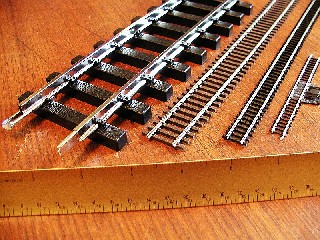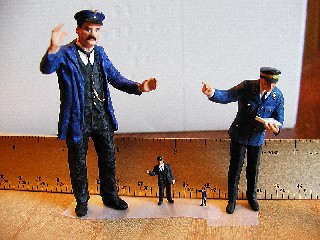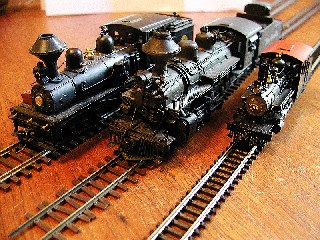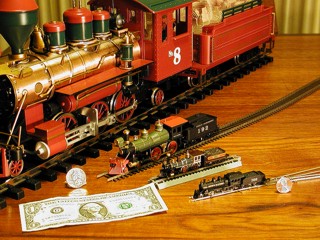— Thomas M. Tuerke
 |
| Gauge is different from scale. Four pieces of track show the difference between 1¾" (G), 16.5mm (HO), 9mm (N), and 6.5mm (Z) gauge. |
Here's a picture that hopefully makes the point. Shown here are four gauges of track. The left one is 1¾-inch gauge, often used by G-scale trains.
Next to that, there is 16.5mm gauge track, which is what is most commonly used for HO scale trains.
Third from the left is 9mm gauge track, which is what is most commonly used for N scale trains.
Finally, at the right is 6.5mm track, used by Z scale trains.
You should be picking up on two things here:
- Gauge is a measurement, the distance between the inside edges of the railheads, so you typically see it expressed as a number. Sometimes, though, you may hear the term HO-gauge track, which just means "the track used by HO scale."
- You may have noticed I said "most commonly used"... more on that later.
So, how does gauge differ from scale? If gauge is a get-out-a-tape-measure sort of number, scale is a honey-I-shrunk-the-trains ratio, like 20-to-1 or 87-to-1 (sometimes written as 1:20 or 1:87, respectively.) It shows how much a model is reduced from the real thing.
 |
| Here are four figures, each in a different scale |
Here we have train conductors in four different scales. The leftmost is usually referred to as G scale, representing a person 1/20th normal height. Next to him is an HO-scale figure, which is 1/87th normal height. The tiniest figure is in Z scale, 1/220th actual size.
So what's with the fourth figure? Well, that's an interesting story... really! The packages says this is a G-scale figure—but obviously the person is not the same size as the leftmost G-scale figure. Actually, G isn't a hard-and-fast scale, but a bunch of scales that all operate on G gauge (1¾-inch) track. In this case, the figure represents a person in 1/32nd scale.
Is that clearer? ;-)
— Thomas M. Tuerke
If your head isn't already spinning, here's some more detail.
Gauge, short and simple, is the distance between the rails. This holds true for full-scale real railroads, and it holds true for models, as we saw above.
I said I'd follow up with that "most commonly used" phrase. Here's what I mean.
Model railroaders generally have two decisions to make when they start: what railroad do they want to model, and what scale do they want to model it in?
Let's say somebody is modelling Union Pacific. Well, that's a standard-gauge railroad: the real thing is built with tracks 4' 8½" apart. They may decide to model it in HO scale, meaning that all their equipment, their track, their scenery—everything—will be represented 1/87th actual size. So they'll use 16.5mm track.
On the other hand, let's say somebody else is modelling the Denver & Rio Grande Railroad. While they may decide to model it in HO scale (using buildings, figures, etc. that are 1/87th actual size,) the real D&RG had tracks that were only 3 feet apart, not 4' 8½". That is to say, it was a narrow-gauge railroad. Modelling that in HO scale means that the 16.5mm track would be too wide.
Somebody else might want to model one of the two-foot gauges found mostly in Maine. While also represented in HO scale, the track on this layout would be far narrower than the 16.5mm gauge normally called for in HO. As it happens, though, N-scale's 9mm track is really very close to what's needed. Since track in this gauge is commercially available, it's common to just use N-gauge track to model HO-scale 2-foot narrow gauge railroads.
So that's where the "most commonly used" comes in.
 |
| These three locomotives are all HO Scale, but they run on different gauge track. |
The picture shown here illustrates the point. All three locomotives shown are HO scale, in that they are 1/87th the size of the real things. The one on the left is a standard gauge Shay locomotive, sitting on 16.5mm track. The middle locomotive is a 3-foot narrow-gauge locomotive, and it's sitting on special HOn3 narrow-gauge track. Finally, the rightmost locomotive is still 1/87th scale but is designed to run on 30-inch track (which just happens to be N-gauge track.)
In the same vein, there's a scale larger than HO called O (which is 1/48th scale as opposed to HO's 1/87th scale.) There's a growing interest in narrow-gauge modelling in that larger scale (allowing more detail, and catering to an aging population.) It should come as no surprise that O scale models depicting 30-inch (2½ foot) gauges can leverage HO's 16.5mm track.
That's why it's important to keep gauge and scale distinct in your mind. One's a number you get from a tape measure or caliper, the other is a ratio....
— Thomas M. Tuerke
Here's an interesting wrinkle learned in a recent trip to Japan.
In Japan, most rail lines are 3'6" inch gauge; only the Shinkansen (bullet train lines) are set at the more customary 4'8.5" gauge (Yes, that means that in Japan, three-foot-six is their standard gauge, and Shinkansen are, to them, broad gauge ;-)
This makes for an interesting situation when modeling. In Japan, space is at a premium, so there, N—not HO—is king. Strictly speaking, N scale is 1/160th of full size, with a track gauge of 9 mm (the name "N", for Nine, comes from this fact.) Both Shinkansen and ordinary trains are modeled to run on N gauge track. So how can this be?
The answer is that only Shinkansen is truly N scale... the ordinary trains that the Japanese model are N gauge (they run on the same track) but they're 1/150th scale, not 1/160th...
Interesting.








 Generate a QR code link to this page
Generate a QR code link to this page